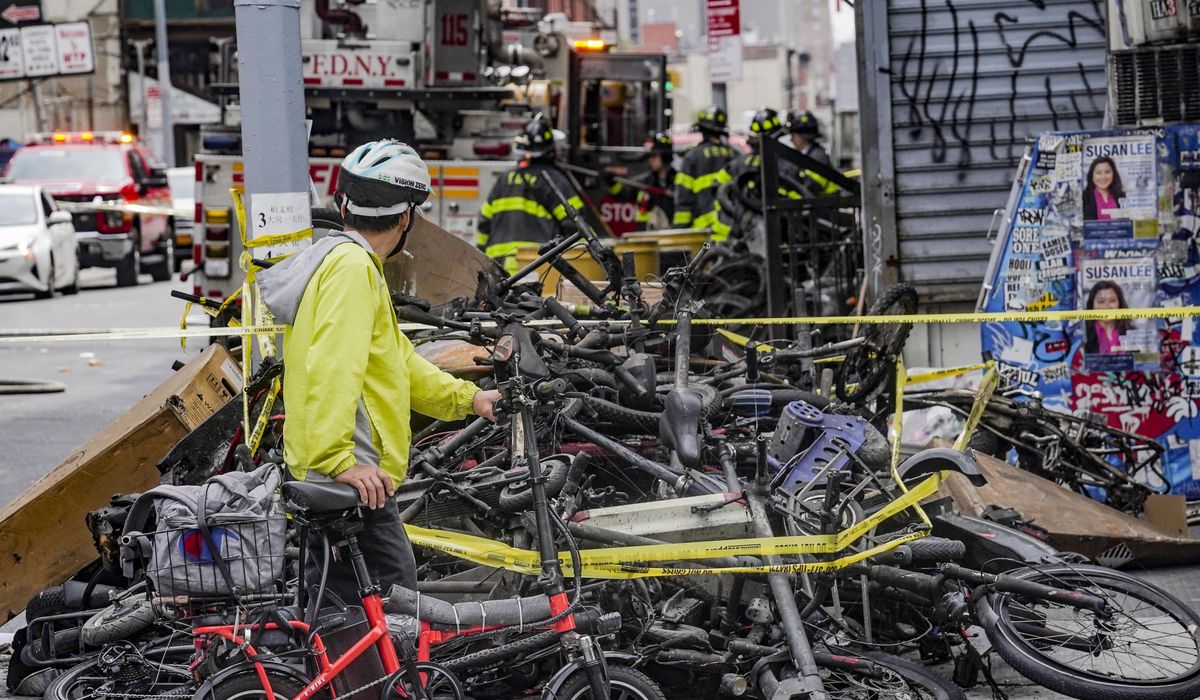


Electric bikes, which are rapidly growing in popularity, are posing an increasing safety risk due to fast-spreading fires caused by the lithium ion batteries that power them.
The growing danger is prompting some lawmakers to push for tighter regulation of the batteries and the bikes.
Experts blame the fires on faulty batteries sold in low-quality, inexpensive electric bikes. The flawed batteries have been particularly deadly in In New York City, where electric bikes are used by tens of thousands of residents and are in some cases left charging overnight in apartment buildings.
If an e-bike battery overheats and explodes, the fire spreads quickly and is difficult to extinguish.
“If you put water on it, it’s not going to die like other fires,” said K.M. Abraham, a research professor at Northeastern University Center for Renewable Energy Technologies.
Mr. Abraham, who helped develop lithium battery technology, told The Washington Times the electric bike fires are likely triggered by poor quality batteries that overcharge, become overheated and then explode.
Mr. Abraham said e-bike owners should not charge them overnight or inside residences, unsupervised.
Industry experts say the dangerous batteries are manufactured with lower standards to cut costs, and are installed in cheaper electric bikes. The less expensive bikes are often purchased by unsuspecting consumers, such as food delivery workers, who may not be able to afford higher-cost, name-brand varieties.
Last month, a faulty battery in an electric bike repair shop in New York City caught fire at night and tore through the apartment building above it, killing four people and seriously injuring several others.
The June 20 tragedy raised the number of New York City deaths caused this year by electric bike battery fires to 13, more than three times the number of such deaths in 2021.
The growing popularity of the bikes, particularly in big cities, has caused the number of battery-related fires to skyrocket. The number of e-bike fires is on course to rise from last year in New York City, according to statistics provided to The Washington Times by the New York City Fire Department.
In 2022, the NYC Fire Department investigated 220 e-bike fires. So far this year, the department has investigated 114 fires believed to be caused by the bikes.
The fires caused by lithium batteries that power “micro-mobility” devices such as electric bikes are a growing nationwide problem that the U.S. has little power to fully regulate.
The Consumer Product Safety Commission reports from 2021 through November 2022, there were 208 fires in 39 states, resulting in 19 fatalities, all caused by the batteries that power electric bikes and other micro-mobility devices such as electric scooters and hoverboards.
In response to the popularity of e-bikes and the increase in fires, the CPSC this year called on manufacturers to comply with voluntary safety standards to ensure the batteries do not pose a fire risk.
But the commission does not have sufficient authority to enforce the requirement, said Light Electric Vehicle Association founder and Chairman Ed Benjamin.
“I think we probably have to have an act of Congress to give the CPSC the teeth” to regulate the batteries, Mr. Benjamin said.
House lawmakers appear to be leaning on the CPSC to ramp up enforcement on its own.
A group of House lawmakers representing New York City wrote last week to the Commission, urging members to take immediate enforcement action against manufacturers who produce batteries that do not meet minimum safety standards.
The CPSC, however, is just now in the process of developing regulations for e-bikes, more than two decades after Congress granted it the authority to do so.
The commission voted in May to accept public comments on whether the commission’s existing regulations adequately address the safety of e-bikes and the batteries that power them.
“More than twenty years ago, Congress authorized CPSC to promulgate regulations to protect the safety of consumers who ride low-speed electric bicycles,” Commissioner Mary T. Boyle said. “The agency has not done so, and it is past time that we take a hard look at whether we should do so now.”
Mr. Benjamin said the bikes are only becoming more popular in the U.S.
More than 1 million e-bikes were imported here last year, and there are about 5 million e-bikes in use.
“The electric bike is something that has utility for Americans,” Mr. Benjamin said. “It really has utility for people living in dense cities.”
In New York City, which has more electric bikes than any other city and where most of the deadly battery fires have occurred, Mayor Eric Adams signed legislation in March requiring e-bike and e-scooter batteries to meet industry safety standards. The legislation banned the resale of bikes and batteries and restricted reconditioning of e-bike batteries.
Firefighters, in the meantime, are grappling with a surge in lithium ion battery fires that are exacerbated by a lack of public awareness about the risks they pose.
Putting out the fire is a challenge, experts said.
Plastic casing on the batteries lengthens the time it takes to extinguish a lithium ion battery fire, allowing it to spread further, and the flames produce toxic fumes.
“It’s a great big hurdle for the fire protection industry,” Brian O’Connor, a fire protection engineer at the National Fire Protection Association, told The Times. “They’re just unique hazards that we’re not used to dealing with.”
• Susan Ferrechio can be reached at sferrechio@washingtontimes.com.
